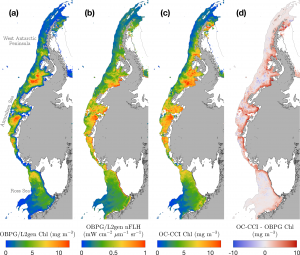Antarctic coastal waters may be more productive than we thought
For years, satellite ocean color measurements have suggested very low productivity near Antarctica’s icy coastlines, which is surprising as Antarctic coastal polynyas (areas of open water surrounded by sea ice) are known hotspots for marine life. In this new paper, we show that we’ve been dramatically underestimating chlorophyll in these crucial ecosystems, with most coastal polynyas showing more than double the net primary productivity previously estimated.

January 10-yr (2010–2019) mean (a) OBPG/L2gen Chl a, (b) OBPG nFLH, (c) OC-CCI Chl a, and (d) difference in Chl a products OC-CCI Chl a minus OBPG/L2gen Chl a, over the west Antarctic shelf.
This underestimate is caused by adjacency effects from ice and snow. When satellites measure ocean color to estimate chlorophyll concentrations, which is used in many productivity algorithms, light bouncing off nearby ice and snow contaminates the signal; this is adjacency. Think of it like trying to photograph a dark object next to a bright white wall—the glare affects how the camera sees the darker area.

Percentage difference in OC-CCI and OBPG/L2gen (a) Chl a and (b) modeled VGPM NPP vs. distance from the coast, in 4-km bins, for January 10-yr average products (2010–2019).
Using improved satellite atmospheric correction methods that better account for this ice glare, we found that over half of Antarctic coastal polynyas are more than twice as productive as standard satellite products suggest. The effect is most pronounced in smaller polynyas and within about 100 km of the icy coast. This work demonstrates that accounting for the optical effects of ice is essential for tracking how polar ecosystems respond to our changing ocean.
Oliver, H., Turner, J.S., Castagna, A., Houskeeper, H. and Dierssen, H. (2025), High Antarctic coastal productivity in polynyas revealed by considering remote sensing ice-adjacency effects. Limnol. Oceanogr. Lett. https://doi.org/10.1002/lol2.70043